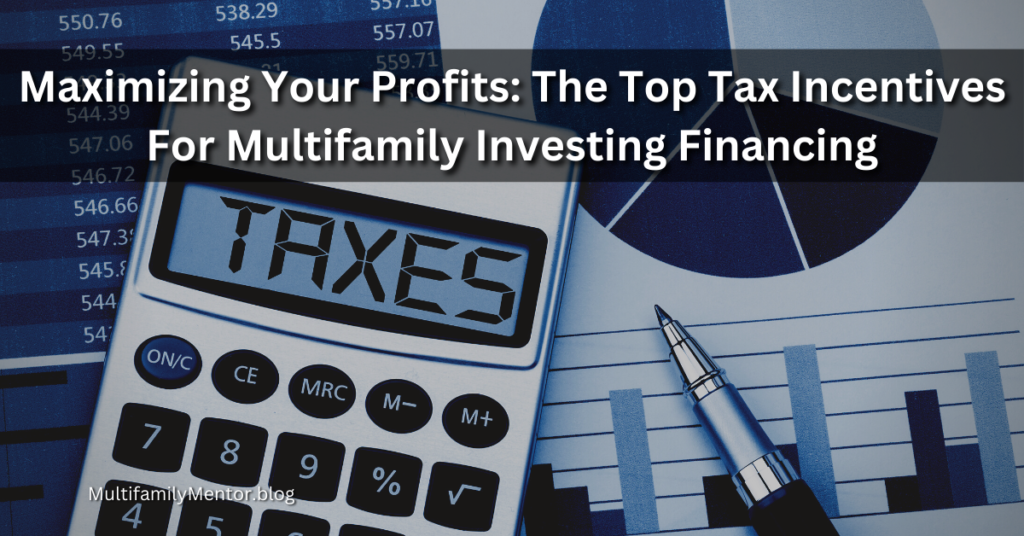Discover the top tax incentives for multifamily investing financing, including depreciation, Section 179 deductions, LIHTC, cost segregation, and energy-efficient upgrades. Maximize your profits with these valuable tax strategies!”
Executive Summary
Investing in multifamily properties can be a lucrative venture, but it can also come with significant financial challenges. Fortunately, there are tax incentives available to investors that can help offset some of these costs. In this article, we'll explore some of the most important tax incentives available for multifamily investors and how you can take advantage of them.
Introduction
Investing in multifamily properties can be a great way to build wealth and generate passive income. However, financing a multifamily property can be a complicated process, and it's important to understand the tax implications involved. In this article, we'll cover the tax incentives that are available to multifamily investors and how you can use them to make your investment more profitable.
Depreciation
Depreciation is a valuable tax deduction that allows investors to deduct a portion of the cost of their multifamily property over time. Here are some important things to know about depreciation:
- Multifamily investors can claim depreciation on the building and any improvements made to it.
- Depreciation is calculated based on the useful life of the property and can be claimed over a period of 27.5 years for residential properties.
- Depreciation can significantly reduce an investor's taxable income and increase their cash flow.
Section 179 Deduction
The Section 179 deduction is a tax incentive that allows investors to deduct the full cost of qualifying equipment and property in the year it was purchased. Here are some key points about the Section 179 deduction:
- The Section 179 deduction can be applied to multifamily properties, as long as the equipment or property being deducted is used for business purposes.
- The deduction limit for 2021 is $1,050,000.
- Qualifying property can include anything from HVAC systems to security systems to landscaping.
Low-Income Housing Tax Credit (LIHTC)
The Low-Income Housing Tax Credit (LIHTC) is a tax incentive designed to encourage the development of affordable housing for low-income families. Here are some important things to know about the LIHTC:
- Multifamily investors can receive LIHTC if they set aside a certain percentage of units in their property for low-income tenants.
- The credit is calculated over a period of 10 years and can be up to 9% of the cost of the property.
- LIHTC can significantly reduce an investor's tax liability and can also be sold to other investors for cash.
Cost Segregation
Cost segregation is a strategy that allows investors to accelerate the depreciation of their property by breaking down the cost of the property into different asset classes. Here are some key points about cost segregation:
- Cost segregation can be a valuable tax planning tool for multifamily investors, as it can help them to maximize their depreciation deductions.
- Cost segregation can be used on new or existing properties, and can also be applied to renovations or improvements.
- It's important to work with a qualified cost segregation specialist to ensure that the strategy is executed correctly.
Energy-Efficiency Tax Incentives
Energy-efficient upgrades can not only help to reduce operating costs, but they can also provide valuable tax incentives for multifamily investors. Here are some important things to know about energy-efficient tax incentives:
- The federal government offers tax credits for certain energy-efficient upgrades, such as insulation, windows, and HVAC systems.
- Some states also offer their own energy-efficiency tax incentives, which can be combined with federal incentives to maximize savings.
- It's important to work with a qualified energy consultant to ensure that the upgrades are eligible for tax incentives.
Conclusion
in multifamily properties can be a smart financial move, but it's important to understand the tax implications involved. By taking advantage of tax incentives like depreciation, the Section 179 deduction, LIHTC, cost segregation, and energy-efficient tax incentives, investors can reduce their tax liability and increase their cash flow. It's important to work with a qualified tax professional and/or real estate attorney to ensure that you're taking full advantage of these tax incentives and staying compliant with all applicable tax laws and regulations.

